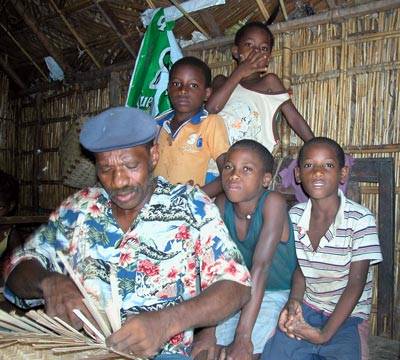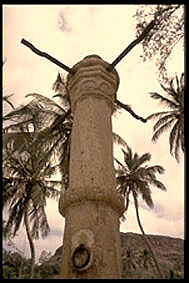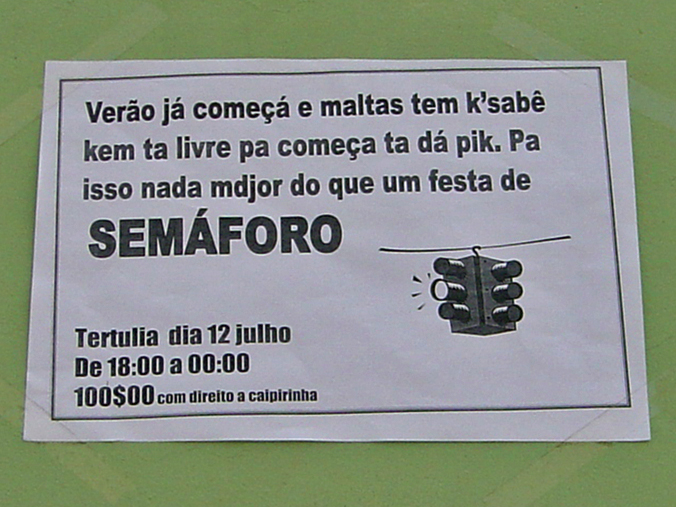|
Rabelados
The Rabelados (from the Portuguese ''rebelados'', "rebels") are a religious community primarily found in the interior of the island of Santiago of Cape Verde. They were among the groups which revolted against the liturgical reforms of the Catholic Church introduced in the 1940s, isolating themselves from the rest of society. History In the 1940s the Catholic Church sent various priests to Cape Verde to replace local priests and introduce alterations in the celebrations of the Mass and other religious customs, particularly religious education. Some groups amongst the population rebelled against these alterations. Known in the Cape Verdean Creole Cape Verdean Creole is a Portuguese-based creole languages, Portuguese-based creole language spoken on the islands of Cape Verde. It is the native creole language of virtually all Cape Verdeans and is used as a second language by the Cape Verd ... language as ''rabelados'' ("rebels"), they came to practice their earlier traditions ... [...More Info...] [...Related Items...] OR: [Wikipedia] [Google] [Baidu] |
Espinho Branco
Espinho Branco is a village in the northern part of the island of Santiago, Cape Verde. In 2010 its population was 869. It is situated near the coast, 5 km northwest of Calheta de São Miguel. Espinho Branco is known for its community of Rabelados The Rabelados (from the Portuguese ''rebelados'', "rebels") are a religious community primarily found in the interior of the island of Santiago of Cape Verde. They were among the groups which revolted against the liturgical reforms of the Catholic ..., a group of people who opposed reforms of the Catholic church and maintain a traditional way of life. Câmara Municipal de São Miguel References {{Subdivisions of Santiago, Cape Verde São Miguel, Cape Verde[...More Info...] [...Related Items...] OR: [Wikipedia] [Google] [Baidu] |
Portuguese Language
Portuguese ( or ) is a Western Romance language of the Indo-European language family originating from the Iberian Peninsula of Europe. It is the official language of Angola, Brazil, Cape Verde, Guinea-Bissau, Mozambique, Portugal and São Tomé and Príncipe, and has co-official language status in East Timor, Equatorial Guinea and Macau. Portuguese-speaking people or nations are known as Lusophone (). As the result of expansion during colonial times, a cultural presence of Portuguese speakers is also found around the world. Portuguese is part of the Iberian Romance languages, Ibero-Romance group that evolved from several dialects of Vulgar Latin in the medieval Kingdom of Galicia and the County of Portugal, and has kept some Gallaecian language, Celtic phonology. With approximately 250 million native speakers and 17 million second language speakers, Portuguese has approximately 267 million total speakers. It is usually listed as the List of languages by number of native speaker ... [...More Info...] [...Related Items...] OR: [Wikipedia] [Google] [Baidu] |
Santiago, Cape Verde
Santiago (Portuguese language, Portuguese for “James, son of Zebedee, Saint James”) is the largest island of Cape Verde, its most important agricultural centre and home to half the nation's population. Part of the Sotavento Islands, it lies between the islands of Maio, Cape Verde, Maio ( to the east) and Fogo, Cape Verde, Fogo ( to the west). It was the first of the islands to be settled: the town of Ribeira Grande (now Cidade Velha and a UNESCO World Heritage Site) was founded in 1462. Santiago is home to the nation's capital city of Praia. History The eastern side of the nearby island of Fogo, Cape Verde, Fogo collapsed into the ocean 73,000 years ago, creating a tsunami high which struck Santiago. In 1460, António de Noli became the first to visit the island. Da Noli settled at ''Ribeira Grande'' (now Cidade Velha) with his family members and Portuguese from Algarve and Alentejo in 1462. [...More Info...] [...Related Items...] OR: [Wikipedia] [Google] [Baidu] |
Cape Verde
Cape Verde or Cabo Verde, officially the Republic of Cabo Verde, is an island country and archipelagic state of West Africa in the central Atlantic Ocean, consisting of ten volcanic islands with a combined land area of about . These islands lie between west of Cap-Vert, the westernmost point of continental Africa. The List of islands of Cape Verde, Cape Verde islands form part of the Macaronesia ecoregion, along with the Azores, the Canary Islands, Madeira and the Savage Isles. The Cape Verde archipelago was uninhabited until the 15th century, when Portuguese Empire, Portuguese explorers colonized the islands, establishing one of the first Age of Discovery, European settlements in the tropics. Due to its strategic position, Cape Verde became a significant location in the Atlantic slave trade, transatlantic slave trade during the 16th and 17th centuries. The islands experienced economic growth during this period, driven by their role by the rapid emergence of merchants, priva ... [...More Info...] [...Related Items...] OR: [Wikipedia] [Google] [Baidu] |
Catholic Church
The Catholic Church (), also known as the Roman Catholic Church, is the List of Christian denominations by number of members, largest Christian church, with 1.27 to 1.41 billion baptized Catholics Catholic Church by country, worldwide as of 2025. It is among the world's oldest and largest international institutions and has played a prominent role in the history and development of Western civilization.Gerald O'Collins, O'Collins, p. v (preface). The church consists of 24 Catholic particular churches and liturgical rites#Churches, ''sui iuris'' (autonomous) churches, including the Latin Church and 23 Eastern Catholic Churches, which comprise almost 3,500 dioceses and Eparchy, eparchies List of Catholic dioceses (structured view), around the world, each overseen by one or more Bishops in the Catholic Church, bishops. The pope, who is the bishop of Rome, is the Papal supremacy, chief pastor of the church. The core beliefs of Catholicism are found in the Nicene Creed. The ... [...More Info...] [...Related Items...] OR: [Wikipedia] [Google] [Baidu] |
Mass (liturgy)
Mass is the main Eucharistic liturgical service in many forms of Western Christianity. The term ''Mass'' is commonly used in the Catholic Church, Western Rite Orthodoxy, Old Catholicism, and Independent Catholicism. The term is also used in many Lutheran churches, as well as in some Anglican churches, and on rare occasion by other Protestant churches. Other Christian denominations may employ terms such as '' Divine Service'' or '' worship service'' (and often just "service"), rather than the word ''Mass''. For the celebration of the Eucharist in Eastern Christianity, including Eastern Catholic Churches, other terms such as ''Divine Liturgy'', ''Holy Qurbana'', ''Holy Qurobo'' and ''Badarak'' (or ''Patarag'') are typically used instead. Etymology The English noun ''Mass'' is derived from the Middle Latin . The Latin word was adopted in Old English as (via a Vulgar Latin form ), and was sometimes glossed as ''sendnes'' (i.e. 'a sending, dismission'). The Latin term itself w ... [...More Info...] [...Related Items...] OR: [Wikipedia] [Google] [Baidu] |
Cape Verdean Creole
Cape Verdean Creole is a Portuguese-based creole languages, Portuguese-based creole language spoken on the islands of Cape Verde. It is the native creole language of virtually all Cape Verdeans and is used as a second language by the Cape Verdean diaspora. The creole has particular importance for creolistics studies since it is the oldest living creole. It is the most widely spoken Portuguese-based creole language. The full, formal name is Cape Verdean Creole (), but in everyday usage the creole is simply called "Creole" () by its speakers. Origins The history of Cape Verdean Creole is hard to trace due to a lack of written documentation and to ostracism during the Portuguese administration of Cape Verde. There are presently three theories about the formation of Cape Verdean Creole. The monogenetic theory of pidgins, monogenetic theory claims that the creole was formed by the Portuguese by simplifying the Portuguese language in order to make it accessible to enslaved Afr ... [...More Info...] [...Related Items...] OR: [Wikipedia] [Google] [Baidu] |
Tarrafal, Cape Verde (municipality)
Tarrafal is a ''Administrative divisions of Cabo Verde, concelho'' (municipality) of Cape Verde. It is situated in the northern part of the island of Santiago, Cape Verde, Santiago. Its seat is the town Tarrafal, Cape Verde, Tarrafal. Its population was 18,565 at the 2010 census, and its area is 120.8 km2. Subdivisions The municipality consists of one ''Administrative divisions of Cabo Verde, freguesia'' (civil parish), Santo Amaro Abade. The ''freguesia'' is subdivided into the following settlements (population data from the 2010 census): *Achada Biscanhos (pop: 310) *Achada Lagoa (pop: 64) *Achada Longueira (pop: 520) *Achada Meio (pop: 211) *Achada Moirão (pop: 587) *Achada Tenda (pop: 1,242, town) *Biscainhos (pop: 695) *Chão Bom (pop: 5,166) *Curral Velho (Santiago), Curral Velho (pop: 358) *Fazenda, Cape Verde, Fazenda (pop: 107) *Figueira Muita (pop: 160) *Lagoa (Tarrafal), Lagoa (pop: 55) *Mato Brazil, Mato Brasil (pop: 160) *Mato Mendes (pop: 194) *Milho Branco ... [...More Info...] [...Related Items...] OR: [Wikipedia] [Google] [Baidu] |
Santa Cruz, Cape Verde
Santa Cruz is a ''concelho'' (municipality) of Cape Verde. It is situated in the eastern part of the island of Santiago. Its seat is the city Pedra Badejo. Its population was 26,617 at the 2010 census, and its area is 112.2 km2. Economy Its economy is based in agriculture, in which rural population produces agricultural commodities for export to larger markets in Praia, Assomada and Fogo. Small market centers exist in São Lourenço dos Órgãos and Pedra Badejo, which act primary as commodity exchanges where subsistence farmers exchange goods as available with merchants who transport and sell goods in larger markets. The primary agricultural productions include fodder (usually in the form of maize stalks), bananas, papayas and coconuts. Prior to 1981 the area also produced a substantial percentage of the island's maize, but the arrival of large-scale international food aid, while vastly improving the region’s food security, made producing foodstuffs unprofitable. Maize a ... [...More Info...] [...Related Items...] OR: [Wikipedia] [Google] [Baidu] |
Religion In Cape Verde
Christianity is the largest religion in Cape Verde, with Roman Catholics having the most adherents. Different sources give varying estimates on the relative sizes of various Christian denominations. More than 94% of the population of Cape Verde is Christian, with almost 85% being Roman Catholic. About 5% of the population is Protestant. The largest Protestant denomination is the Church of the Nazarene.International Religious Freedom Report 2022: Cape Verde United States Bureau of Democracy, Human Rights and Labor. ''This article incorporates text from this source, which is in the |
History Of Santiago, Cape Verde
Santiago ( Portuguese for “ Saint James”) is the largest island of Cape Verde, its most important agricultural centre and home to half the nation's population. Part of the Sotavento Islands, it lies between the islands of Maio ( to the east) and Fogo ( to the west). It was the first of the islands to be settled: the town of Ribeira Grande (now Cidade Velha and a UNESCO World Heritage Site) was founded in 1462. Santiago is home to the nation's capital city of Praia. History The eastern side of the nearby island of Fogo collapsed into the ocean 73,000 years ago, creating a tsunami high which struck Santiago. In 1460, António de Noli became the first to visit the island. Da Noli settled at ''Ribeira Grande'' (now Cidade Velha) with his family members and Portuguese from Algarve and Alentejo in 1462.Valor simbólico do cen ... [...More Info...] [...Related Items...] OR: [Wikipedia] [Google] [Baidu] |





